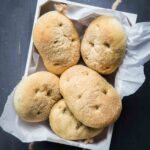
Potato-shaped Potato Bread (Gamja Ppang)
Servings: 8 large buns
Calories: 487kcal
Whether you’re looking for a fun treat or a comforting snack, this potato-shaped bread offers a deliciously playful way to enjoy the simple potato.
Print Recipe
Ingredients
For the dough:
- 350 g bread flour plus more for dusting
- 1 tsp instant yeast
- 20 g sugar
- 56 g unsalted butter softened
- 80 g whole milk plus more as needed
- 50 g eggs
- 5 g salt
For the dough and filling:
- 500 g potatoes divided
Filling:
- 100 g ham diced
- 120 g mozzarella cheese shredded
- 75 g sweet corn thawed if frozen
- 60 g kewpie mayo or regular mayo
- ¼ tsp ground black pepper
- Salt to taste
For coating:
- 120 g soybean flour or oat flour
- small pinch of charcoal powder or finely ground black sesame powder
Instructions
- Get about 500 grams of potato (a little over a pound). Dice them into small pieces
Prepare the potatoes and corn:
- Bring a medium-sized pot of water to a boil. Add the potatoes and cook until they are fork-tender but not mushy, maybe about 5 minutes or less. Drain off the boiling water.
- Mash the potatoes with a fork or potato masher. Get about 140 grams (2/3 cups) for the dough and the rest for the filling. Let it cool down to at least lukewarm before using it to prepare the dough
- I use frozen sweet corn, which I thawed. If you use fresh corn kernels that you shuck on your own, boil them in water for 2-3 minutes and then drain off the cooking water
Prepare the dough:
- Put all the ingredients for the dough in a mixing bowl of a standmixer. Add the 140 g (2/3 cups) mashed potatoes. Use a dough hook attachment to stir the mixture a little bit so the dry ingredients won't fly all over when you start the machine
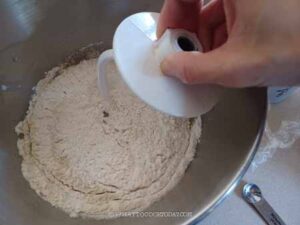
- Start kneading the dough on speed 2 (on KA) for 2 minutes and then increase the speed to 4 and continue to knead until the dough is smooth, another 5 minutes or so. The dough still feel a bit sticky and soft and it will clear the sides of the bowl but still stick to the bottom of the bowl. Use a bench scraper or a sturdy spatula to scrape the sides of the bowl halfway through kneading to make sure all ingredients are kneaded
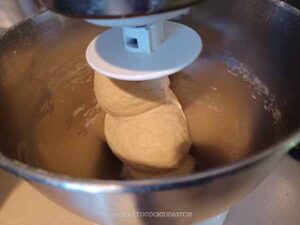
First proofing:
- Lightly oil a large container and transfer the dough into the container. Cover and let it proof at a warm place (around 82 F/28 C is ideal) for about 1- 1/2 hours, depending on the temperature, until the dough doubles in volume
Prepare the filling:
- While the dough is proofing, prepare the filling. Add the rest of the mashed potatoes, corn kernels, kewpie mayo, shredded mozzarella, ground black pepper, diced ham. Stir everything to combine. Have a taste and adjust seasoning by adding more salt and/or pepper if needed. Cover and set aside in the fridge
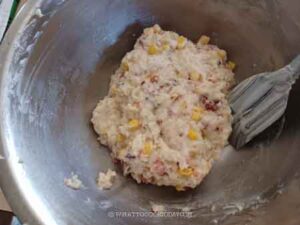
Prepare the coating:
- I use soybean flour (kinako). If you don't have any, oat flour works too. I just use a high-speed blender to blend roll oats into fine powder form. Mix with a tiny pinch of charcoal powder for a more darker rustic look
Shaping:
- Line 1 large baking sheet with parchment paper. You can use two baking sheets to give you more space too
- Deflate the dough, by folding the edge of the dough towards itself until the air is deflated. Transfer to a lightly floured surface.
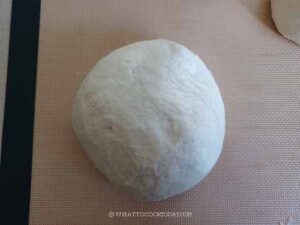
- Divide the dough between 5-10 pieces, depending on how large or small you want the potato bread to be
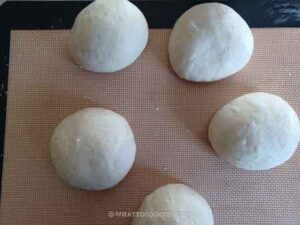
- The dough feels a bit sticky and that's normal. Lightly dust your work surface and your hands and pick up one dough and flatten it into about 5-6 inches roundish or ovalish shape (it doesn't have to be exact). Pile some of the filling onto the center of the dough.
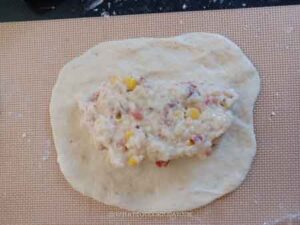
- Gather the edge of the dough towards the center to enclose the filling. Pinch the dough together to seal. Make sure you seal it really well. The shape can be irregular, just like how some potatoes are more roundish, some are more ovalish in shape. No right or wrong here
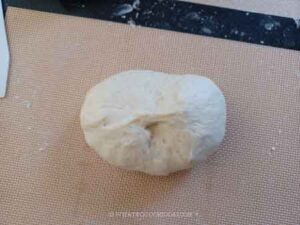
- Roll the dough with the roasted soybean flour to coat the entire dough. Place the dough on a baking sheet, about 2-3 inches apart. Repeat with the rest of the dough
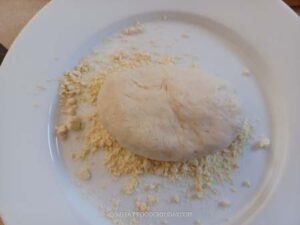
- Use a chopstick or the blunt side of a skewer to create some deep indentation into the dough, some are smalls, some a bit lager. This is to mimic the "eye" on the potato skin
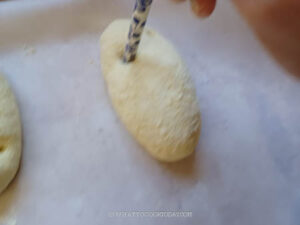
Second proofing:
- Cover the dough with a clean kitchen towel and let them proof at a warm place again until they are puffy, about 1 hour or so.
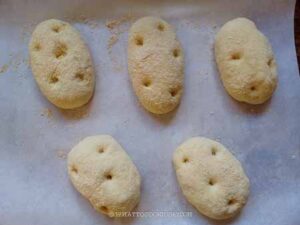
- When you gently press on the dough, it bounces back slowly and leave some indentation. The dough is done proofing. If it bounces back immediately, proof them a bit longer.
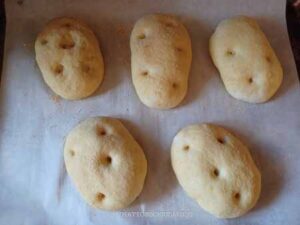
Baking:
- 10 minutes before the end of second proofing, preheat the oven to 375 F (190C) for convention oven, 350 F (180 C) for convection oven.
- I recommend baking one tray at a time if you use two baking sheets. Bake for 15-18 minutes or until the bread is lightly golden brown and if you have an instant-read thermometer, it should read at least 190 F (88 C)
Cooling:
- Remove the baking sheet from the oven and place on a cooling rack. Carefully transfer the bread to a cooling rack to let them cool down. You can serve this warm or room-temperature
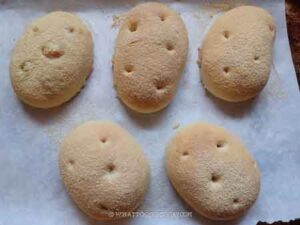
Nutrition
Serving: 1bread | Calories: 487kcal | Carbohydrates: 54g | Protein: 20g | Fat: 22g | Saturated Fat: 8g | Polyunsaturated Fat: 6g | Monounsaturated Fat: 6g | Trans Fat: 0.2g | Cholesterol: 62mg | Sodium: 701mg | Potassium: 794mg | Fiber: 5g | Sugar: 5g | Vitamin A: 376IU | Vitamin C: 13mg | Calcium: 141mg | Iron: 2mg